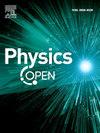通过交错光束线实现pev尺度中微子-质子碰撞的模拟研究
IF 1.4
Q2 Physics and Astronomy
引用次数: 0
摘要
本文介绍了一种新的基于加速器的方法,在受控的实验室环境中实现能量从10到100 PeV的中微子-质子相互作用。通过采用介子衰变隧道和质子束线的交错配置,该方法有效地抵消了中微子束的发散,在狭窄的中微子束和质子束之间形成重复的重叠。模拟使用了未来圆形对撞机的参数,包括μ子冷却来提高事件率,证明了每年在这些超高能量下产生数百到数千个事件的潜力。虽然提议的装置提出了非常重大的技术挑战,但它可能会在中微子物理学中开辟一个新的能量范围,使中微子-核子横截面的精确测量成为可能,这是解释高能天体物理中微子信号和测试基础物理所需要的。除了本文探讨的具体实现之外,交错光束线技术可以成为未来新型加速器设计的基础。与介子对撞机等新兴技术的集成可以克服光束聚焦、发射度或目标耐用性方面的限制。本文章由计算机程序翻译,如有差异,请以英文原文为准。
A simulation study to achieve PeV-scale neutrino–proton collisions via staggered beamlines
This paper introduces a novel accelerator-based method to achieve neutrino–proton interactions at energies from 10 to 100 PeV in a controlled laboratory environment. By employing a staggered configuration of a pion decay tunnel and a proton beamline, the method effectively counters neutrino beam divergence, forming repeated overlaps between narrow neutrino beams and the proton beam. Simulations, using parameters from the Future Circular Collider and including muon cooling to enhance event rates, demonstrate the potential to generate hundreds to thousands of events annually at these ultra-high energies. While the proposed setup presents very significant technological challenges, it could potentially open a new energy range in neutrino physics, enabling precise measurements of neutrino-nucleon cross-sections needed for interpreting high-energy astrophysical neutrino signals and for testing fundamental physics. Beyond the specific implementation explored here, the staggered beamline technique could be a basis for future novel accelerator designs. Integration with emerging technologies like muon colliders could overcome limitations in beam focusing, emittance, or target durability.
求助全文
通过发布文献求助,成功后即可免费获取论文全文。
去求助
来源期刊

Physics Open
Physics and Astronomy-Physics and Astronomy (all)
CiteScore
3.20
自引率
0.00%
发文量
19
审稿时长
9 weeks
 求助内容:
求助内容: 应助结果提醒方式:
应助结果提醒方式:


